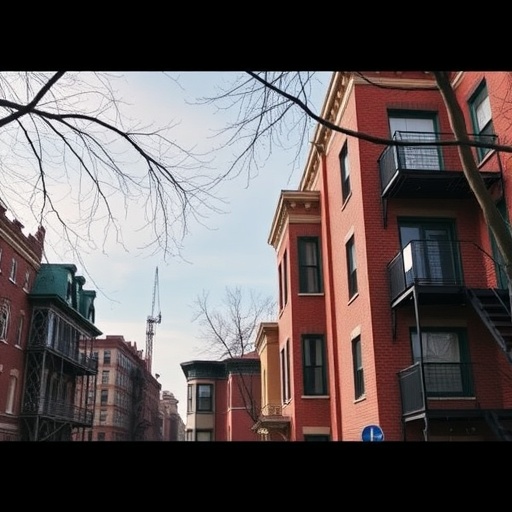Chicago‘s $640 Million Migrant Spending Under Fire as Black Tenants Battle Severe Housing Crisis
In a city already strained by economic disparities, Chicago‘s decision to pour $640 million into migrant accommodations has ignited a firestorm of controversy, leaving Black tenants to fend for themselves amid a deepening housing crisis. As buses from Texas continue to unload asylum seekers at shelters and makeshift hotels, residents in predominantly Black neighborhoods are grappling with skyrocketing evictions and crumbling apartment buildings, raising urgent questions about racial equity in resource allocation.
The tension boiled over last week when community activists staged a protest outside City Hall, chanting “Equity Now!” and holding signs that read “Migrants Get Hotels, We Get Hazards.” This isn’t just a flashpoint—it’s a symptom of broader inequities that have simmered for years in Chicago, where the arrival of over 30,000 migrants since 2022 has stretched city budgets thin while long-standing issues for Black tenants remain unaddressed.
Migrant Influx Triggers Unprecedented Budget Surge
Since August 2022, Chicago has become a reluctant hub for migrants bused in from the southern border, primarily from Venezuela and other Latin American countries. The city’s response has been swift and costly: an initial $150 million emergency allocation in 2023 ballooned to $640 million by mid-2024, funding everything from temporary shelters in police stations to long-term leases on motels and the conversion of warehouses into dormitories.
According to a recent report from the city’s Budget Office, over 40% of this migrant spending—roughly $256 million—has gone toward housing alone, including $100 million for hotel contracts and $50 million for site preparations at former military bases on the South Side. Mayor Brandon Johnson’s administration defends the outlay as a humanitarian necessity, with spokesperson Mary O’Brien stating, “We cannot turn our backs on those fleeing violence; this is Chicago’s moral obligation.”
Yet, the numbers tell a stark story. The migrant population peaked at 18,000 in shelters last winter, forcing the city to activate over 20 emergency sites. This has diverted funds from other pressing needs, including a 15% cut to affordable housing programs for low-income residents, as outlined in the 2024 fiscal budget. Critics argue this migrant spending prioritizes newcomers over citizens who’ve endured generational neglect.
Statistics from the Chicago Department of Housing underscore the scale: In 2023, the city processed 1,200 work permits for migrants and provided $20 million in direct aid for food and healthcare, amounts that dwarf similar support for local vulnerable groups. One surprising angle is the economic ripple—migrants have filled labor gaps in construction and service industries, contributing an estimated $200 million to the local economy through jobs and spending, per a University of Illinois study. But for many Black tenants, this feels like cold comfort amid their own struggles.
Black Neighborhoods Hit Hardest by Eviction Wave
While migrants settle into funded accommodations, Black tenants in neighborhoods like Englewood and Austin face a relentless housing crisis that threatens to displace thousands. Eviction filings in majority-Black zip codes surged 25% in 2023, reaching 12,000 cases citywide, according to data from the Eviction Lab at Princeton University. This spike coincides with a 10% rise in rent prices, pushing the average one-bedroom apartment to $1,800 monthly—unaffordable for the median Black household income of $45,000.
Take the story of Maria Jenkins, a 52-year-old nurse from Woodlawn. Her family’s century-old apartment building, plagued by leaky roofs and faulty wiring, was cited for 47 code violations last year. “We’ve been begging the city for help since the ceiling collapsed in 2022, but nothing. Meanwhile, I see buses dropping off families at the fancy hotels down the street,” Jenkins told reporters during a tenant rally. Her plight mirrors hundreds of others: The Chicago Building Department issued over 5,000 emergency repair orders in Black-majority areas in 2023, but only 30% were resolved due to funding shortages.
The housing crisis for Black tenants isn’t new—it’s rooted in redlining legacies that concentrated poverty in the South and West Sides. Today, 70% of Chicago’s public housing waitlist—over 40,000 households—is Black, yet voucher programs received just $80 million in city funding last year, a fraction of the migrant spending. Activists point to a 2024 HUD report showing Black renters are three times more likely to face substandard conditions than white counterparts, with lead paint and mold affecting 25% of units in Black neighborhoods.
- Key Stats on the Crisis: 15,000 Black families at risk of homelessness in 2024 (per Chicago Coalition for the Homeless).
- Black homeownership rate: 45%, compared to 75% for whites (U.S. Census).
- Over 300 buildings in disrepair, with $2 billion needed for renovations citywide.
This disparity has fueled accusations of systemic bias, with community leaders like Rev. Jesse Jackson Sr. warning, “Chicago’s racial equity promise is hollow if we fund outsiders while our own are evicted.”
Community Backlash Highlights Racial Equity Divide
The protests aren’t isolated; they’ve galvanized a coalition of over 20 neighborhood groups under the banner “Chicago for All.” At a packed town hall in Bronzeville last month, speakers unpacked the racial equity chasm. “Why are we spending millions on migrants when Black mothers are losing their homes to slumlords?” demanded organizer Tamika Mallory, echoing sentiments from 500 attendees.
Polls reflect the divide: A Northwestern University survey found 62% of Black Chicagoans view migrant spending as unfair, compared to 35% of white residents. This sentiment has permeated social media, with hashtags like #EquityForChicago trending and viral videos of dilapidated buildings juxtaposed against migrant shelters amassing millions of views.
Surprising alliances have formed too—labor unions, typically supportive of immigrant rights, have joined calls for balanced funding, citing a 20% drop in affordable housing construction starts since the migrant surge began. One union rep, Carlos Rivera, noted, “We welcome workers, but not at the expense of our Black brothers and sisters who’ve built this city.”
Legal challenges are mounting: A class-action lawsuit filed by the Chicago Lawyers’ Committee for Civil Rights alleges that migrant spending violates the city’s equity ordinance by disproportionately benefiting non-residents. If successful, it could redirect up to $100 million toward Black tenants‘ repairs.
Experts weigh in on the deeper narrative. Dr. Imani Perry, a Harvard professor specializing in urban studies, observes, “This is classic zero-sum politics, but the real issue is failed policy. Chicago’s racial equity framework, adopted in 2021, mandates inclusive budgeting—yet migrant spending has bypassed it, exacerbating the housing crisis.” Her analysis highlights how federal funds, like $300 million in FEMA reimbursements for migrants, could have been leveraged for local needs but weren’t.
City Hall Grapples with Budget Balancing Act
Mayor Johnson’s office faces mounting pressure to reconcile these tensions. In a press conference on October 15, 2024, the mayor acknowledged the strain: “We’re committed to racial equity, but the migrant crisis is a national failure dumped on our doorstep. We’ve housed 25,000 people without major incidents—that’s a win, but we hear the calls for balance.”
Proposed solutions include a $150 million bond for housing repairs targeted at Black tenants, funded partly by reallocating unspent migrant spending. Alderman Pat Dowell (3rd Ward) introduced legislation to cap migrant hotel contracts at $200 million annually, redirecting savings to a “Racial Equity Housing Fund.” However, implementation hurdles loom: The city council is split, with progressive aldermen defending the spending and South Side representatives demanding veto power over new sites.
Behind the scenes, negotiations with state and federal officials could inject $500 million more for comprehensive housing, including subsidies for Black tenants. Governor J.B. Pritzker has pledged $250 million, but strings attached—migrants must be integrated into workforce programs to qualify for aid. This could create 5,000 jobs, potentially easing the housing crisis by boosting incomes, but skeptics fear it won’t address immediate evictions.
- Federal Aid Dynamics: Chicago has received $160 million from DHS for migrants, but only $50 million for local housing since 2020.
- Local Innovations: Pilot programs in Austin are testing community land trusts to prevent displacement, serving 200 families so far.
- Political Ramifications: The issue could sway the 2027 mayoral race, with equity becoming a litmus test.
Personal stories humanize the debate. Jamal Thompson, a 35-year-old father from Garfield Park, shared his eviction nightmare: “My building’s been condemned, but the city’s too busy with migrants to fix it. My kids deserve better than sleeping in a shelter.” His testimony at a council hearing moved lawmakers to tears, underscoring the emotional toll.
Path Forward: Reforms to Bridge Chicago’s Housing Divide
As winter approaches, with forecasts of another 10,000 migrant arrivals, Chicago stands at a crossroads. Advocates are pushing for a “Housing Equity Summit” in November, aiming to forge a blueprint that integrates migrant needs with those of Black tenants. Potential outcomes include zoning reforms to build 5,000 mixed-income units by 2026 and expanded rent relief programs covering 15,000 households.
Looking ahead, experts predict that without intervention, the housing crisis could displace 20,000 more Black tenants by 2025, deepening racial equity rifts. Yet, glimmers of hope emerge: Partnerships with nonprofits like the Resurrection Project are training migrants for construction roles to repair neglected buildings, creating a symbiotic solution.
City Comptroller Chuy Garcia warns of long-term fiscal risks if migrant spending continues unchecked, projecting a $300 million deficit by 2025. But optimists like housing advocate Sunia Zater point to success stories in other cities, such as Denver’s balanced approach, which combined migrant aid with $100 million for locals. “Chicago can lead if it prioritizes people over politics,” she says.
Ultimately, resolving this divide requires bold action: Auditing past migrant spending for equity compliance, launching a $1 billion infrastructure bond, and fostering dialogues that heal community wounds. As one resident put it, “We’re all Chicagoans—let’s build a city where no one is left behind.” The coming months will test whether leaders can turn rhetoric into reality, ensuring racial equity isn’t just a buzzword but a lived promise.









